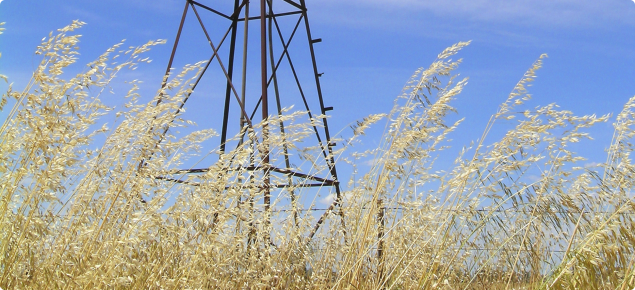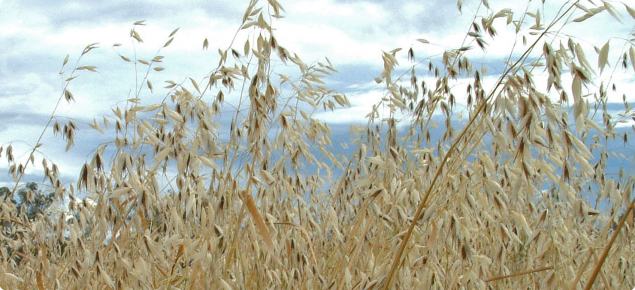Identification and attributes
Latin names: Avena fatua and Avena ludoviciana
Common names: Wild oats, black oats.
Distinguishing features
Wild oats have a large ligule with no auricles and the leaves tend to be hairy with a slight bluish hue. The emerging leaf is rolled. The seedling leaves are twisted anticlockwise, the opposite direction to wheat and barley. Wild oat seeds are usually dark but can vary through to cream. Hairiness of seeds also varies.
Wild oats tend to grow in discrete patches at low to moderate densities (up to 100 plants/m2) and can be confused with brome grass in the seedling stage. All Bromus spp. have tubular leaf sheaths and hairy leaves and sheaths while wild oats exhibit a rolled sheath and few hairs on the leaves.
Biology
Opening autumn rains encourage germination of 40% of wild oat seeds, with a further 10-30% germinating later during the season. Direct drilling retains most wild oat seed near the soil surface, resulting in a quicker seedbank turnover rate. Most of the seeds will emerge from the top 50-75 millimetres (mm) of soil.
The half-life of wild oat seed is about six months, equating to 75% depletion during 12 months. Trial work in northern New South Wales during the 1990s has shown that after seed production has ceased the seedbank can be depleted to extremely low numbers within 3-5 years. Deep burial of wild oat seed will increase survival times.
Why is it a weed?
The annual cost to the Australian wheat industry of wild oats during 1999 was estimated to be $80 million, with $60 million being spent on herbicides and their application and $20 million in lost yield.
Wild oats are highly competitive and when left uncontrolled, can reduce wheat yields by up to 80%. Greatest yield loss occurs when the plants emerge at the same time as the crop. They produce a large number of seeds and up to 20 000seeds/m2 can be produced by uncontrolled infestations.
Wild oats avoid early herbicide applications as a proportion of the seeds germinate later than the crop.
Wild oats are easily spread as contaminants of grain, hay and machinery. Up to 75% of wild oat seed can be collected at harvest, with seeds being transported up to 250 metres (m) from the parent plant by the harvest operation. Delaying harvest can reduce seed movement in the paddock and grain sample, as the delay means a greater proportion of the wild oats seeds will have shattered.
Wild oats act as a host for a number of important cereal diseases including cereal cyst nematode (Heterodera avenae), stem nematode (Ditylenchus dipsaci), rhizoctonia (Rhizoctonia solani), crown rot (Fusarium graminearum) and root lesion nematode (Pratylenchus neglectus).
Herbicide resistance
Wild oats can easily develop resistance to herbicides. Group A herbicide resistance, predominately to ‘fop’ herbicides (for example, Topik®), has been present in Australian populations of wild oats since the mid 1980s. In Western Australia, wild oats are currently resistant to:
- Group A — ‘fop’ (for example, diclofop-methyl)
- Group A — ‘dims’ (for example, tralkoxydim)
In Australia , wild oats are also currently resistant to Group B - sulfonylureas (for example mesosulfuron) and Group Z (for example flamprop-methyl).



